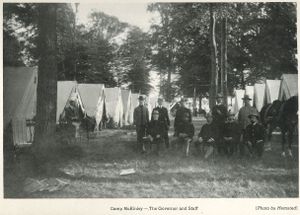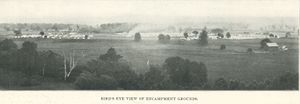State Encampment Ground
The State Encampment Ground, also known as Camp William McKinley, Camp Buckeye, and the State Camp Grounds, occupied the Octagon Earthworks (one of the major components of the Newark Earthworks) and surrounding land west of Downtown Newark from 1892 until 1908.
State legislation created a "State Encampment Ground" for Ohio in 1891. Such a site would serve as a training facility for Ohio military regiments. The land the camp needed to be within sixty miles of the geographic center of the state, limiting the counties and communities that would be eligible to host Ohio's military units. A local committee from Licking County—Senator W.E. Miller, Colonel W.C. Wells and Captain F. G. Warden—successfully petitioned the state commission to place the encampment around the Octagon Earthworks as a way to preserve the monuments, and to bring increased prestige and commerce to the county. Newark's ample railroad connections, which permitted easy access to the far-flung corners of the state, also assisted in the awarding of the encampment. The city of Newark raised bonds and purchased 141 acres for the purpose of the encampment. [1]
Units of the Ohio National Guard came to Newark and the Encampment Ground in the summer to train: erecting tents, running drills, and practicing marksmanship and artillery. Guardsmen were transported to Newark and provided with their meals at camp. This created an influx of money to the county with goods purchased to supply men and horses, and local civilians were employed in cooking and maintenance. The Encampment grounds included one hundred and forty-two acres and extended across the Octagon Earthworks, including the Octagon and Observatory Circle. [2] The state military also worked to restore the Native American earthworks; prior to the creation of the Encampment, parts of the Octagon Earthworks had been eroded through agriculture, but the State worked to repair the damage and preserve them. [3]
Camp McKinley
The first use of the title "Camp McKinley," or "Camp M'Kinley," for the Encampment Grounds may have appeared in the Newark Daily Advocate on October 18, 1901, a little over a month after President McKinley's assassination. [4] The local use of the name may have reflected a growing state consensus that the Encampment Grounds would be renamed after the deceased president from Ohio. The name change became official in 1902 when the yearly gatherings took place in the rechristened "Camp William McKinley." [5] In 1903, as many as thirty-five hundred soldiers were encamped at the site with canon mounted on embankments. [6] Camp McKinley continued to function as a military training site for a few more years, but numbers of participants and activity declined after 1904 and the state had discontinued use of the site by 1907.
In March 1908, the state legislature voted to return the property to the city and county. Such a reversion to local control had been established in the initial contract for the encampment. During the negotiations at the state level, it was suggested, but never enacted, that the grounds might be used for a planned, state facility for disabled children. [7] Whatever the specific use of the location might entail, all parties involved with the project were of the consensus that the Earthworks, which formed the core of the encampment site, must be preserved.
When the property reverted to the city and county, Newark's Board of Trade, an organization made up of prominent businessmen, was designated as the trustee of the property and charged with finding a use for the site. In 1910, the Board of Trade decided to grant a lease of the State Encampment Grounds to the newly formed Licking Country Club with a twenty-year lease of the property for an annual fee of $650. A golf course was installed and a clubhouse erected and opened on June 15, 1911, which would become the Moundbuilders Country Club. [8] This decision by the Board of Trade was not without controversy at the time; the organizers of the County Club were made up of Board of Trade members and admittance to the Club would be costly, prohibitively so to many. The city's finances were not able to support a large public park at that time, but many residents wanted the acreage and Earthworks converted into a public park. On March 6, 1912, the County Commissioners addressed this concern by reaffirming the Board of Trade's stewardship of the site and the eventual conversion of the grounds "for a public park when it will be acceptable for said purpose." [9] This began a new era for the site and the Octagon Earthworks as they transitioned from military encampment to golf course and country club.
For more information on the State Encampment Grounds see:
Photographic History of Newark and Licking Co.
Ohio National Guard Activities at the Newark Works by James Murphy
J.G.
Return to Historic Sites and Buildings
References
- ↑ "Encampment Ground May Soon be Deeded Back to the City", The Newark Advocate, Mar. 19, 1908, 1.
- ↑ Simkins, J.D., "Newark as a City of Homes and Health," The Ohio Magazine, July 1907, 67-68
- ↑ Photographic History of Newark and Licking Co.,, (1904)
- ↑ "Camp M'Kinley," The Newark Daily Advocate, Oct. 18, 1901, 6
- ↑ "Troop," The Newark Advocate, Jun. 9, 1902, 3
- ↑ Metz, W., Prehistoric Remains in Licking County, Ohio. (1904), 12-13.
- ↑ "Encampment Ground May Soon be Deeded Back to the City", The Newark Advocate, Mar. 19, 1908, 4.
- ↑ "Handsome New Home of County Club will be Opened June 15," The Newark Daily Advocate, Jun. 5, 1911, 7
- ↑ "Commissioners and City Council Joint Meeting," The Newark Daily Advocate, Mar. 7, 1912, 4


